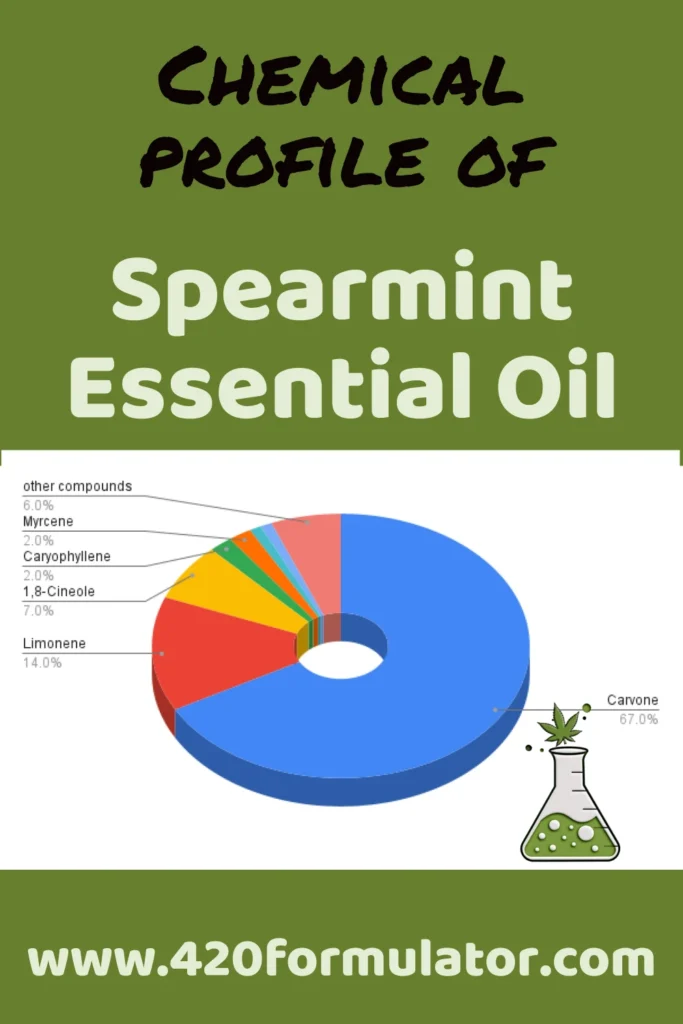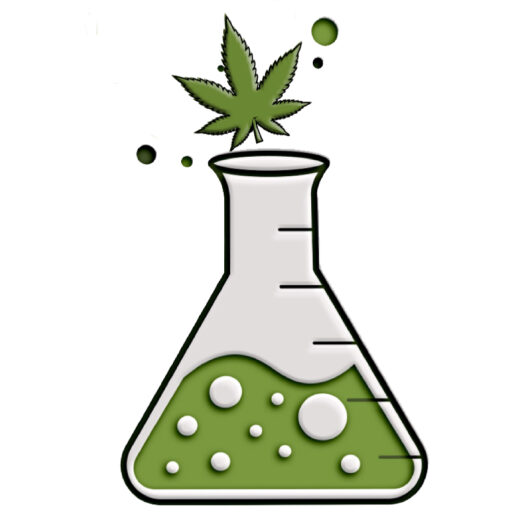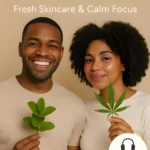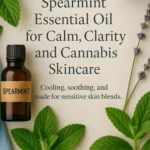Spearmint essential oil has a softer, more grounded edge than Peppermint. It’s fresh, cooling, and clears the head without the harshness. If you’re working with cannabis topicals or blends for clarity, calm, or skin tension, this one is worth a closer look.
Table of Contents
*As an Amazon Associate, I earn from qualifying purchases
Botanical Name and INCI
The botanical name for spearmint is Mentha Spicata. It’s part of the mint family (Lamiaceae) and grows easily across Europe, North America, and Asia. The INCI name may differ by supplier and can appear as Mentha Spicata Herb Oil or Mentha Viridis Leaf Oil.
History and Traditional Use
Spearmint has a long and practical history across herbal traditions. In Ancient Greece, and it was was often infused in wine to ease digestion and calm the nerves. It was also used to scent bathwater and treat respiratory conditions. Roman naturalists like Pliny the Elder wrote about its use to sharpen the mind and soothe headaches.
In Traditional Chinese Medicine, Spearmint (Bo He) is cooling and aromatic. It is used to clear heat, especially in the head, throat, and skin. It’s traditionally prescribed for headaches, sore throats, and emotional tension, especially where stagnation or heat is involved.
Ayurvedic practitioners classify Spearmint as light and cooling, suited to reducing excess Pitta. It has been used to support digestion, mental clarity, and hormonal balance, especially in women’s health.
Indigenous communities in Northern America used native mint species, like Spearmint, in poultices and teas to relieve nausea, menstrual pain, and fevers. While essential oils were not part of early practices, their distilled forms are now widely utilised both topically and aromatically to address tension, inflammation, and nervous disorders.
Extraction Method
Spearmint essential oil is typically extracted through steam distillation of the fresh or partly dried flowering tops. The resulting oil is pale yellow to greenish and has a crisp, sweet-herbaceous aroma with a soft minty undertone. It’s far less intense than Peppermint and sits nicely as a middle to top note in perfumery and aromatherapy.
The oil’s fragrance is clean and uplifting without being overpowering. It’s stable in formulations, but should still be added during the cool-down phase in emulsions to preserve its aroma and terpene content.
Chemical Profile

Spearmint oil is dominated by ketones and monoterpenes, giving it a gentle but complex profile. These compounds offer both skin-soothing and mentally clarifying effects, which make it a good partner for cannabis-rich formulations.
- Carvone (50% to 70%): The signature ketone in Spearmint. Antispasmodic, antimicrobial, antioxidant, calming, and supports digestive and nervous system functions. Topically, it’s useful for tension, muscle tightness, and inflammatory skin conditions.
- Limonene (5% to 15%): A citrus-scented monoterpene with uplifting, anti-inflammatory, and mildly antifungal effects. Limonene helps other compounds and cannabinoids penetrate the skin in topical applications, which boosts the overall efficacy of a blend. It’s a good antioxidant (therefore a good anti-inflammatory agent), antifungal, and a stimulant.
- Beta-Pinene (1% to 4%): Brings antimicrobial and expectorant properties. Useful for sinus congestion, respiratory blends, or blemish-prone skin.
- 1,8-Cineole (up to 2%): This monoterpene alcohol is a strong pain reliever, making Spearmint effective for toothaches and muscle rubs. It is also known as Eucalyptol that helps to clear chest congestion and help you to breathe deeper. It’s a good anti-inflammatory agent, antispasmodic, antibacterial, antifungal, and antiviral. It adds freshness and mental clarity supporting airway opening and enhances Spearmint’s ability to cut through fog or fatigue.
- Myrcene (traces): A sedative and anxiolytic, which makes it a very calming oil when applied in a dilution topically. It’s also anti-inflammatory, and mildly analgesic for tired muscles. Myrcene is found in many cannabis cstrains, and though minor in Spearmint, it can complement calming blends.
- Menthone (1% to 5%): Cooling, slightly analgesic, and toning. Helps with swelling, muscle tension, and menstrual discomfort in topical blends.
- Octanol / Octan-3-ol (minor): Has a fruity-green note and potential antifungal action. It really brings out the nice, subtle smell of Spearmint.
- Caryophyllene is a powerful terpene. It’s an effective antiseptic that, with the Menthol in the oil, helps fight bacteria and prevent skin infections. The oil does have a good reputation as a wound healer and is anti-inflammatory. There is research ongoing about its efficacy as a skin treatment for various skin conditions, including eczema and acne.
- Pinene refers to both Alpha-Pinene and Beta-Pinene, two related terpenes known for their fresh, pine-like aroma. These compounds are commonly used in fragrances, household products, food flavorings, and cleaning products. Research indicates that pinene may reduce inflammation and help relieve respiratory congestion by clearing mucus and phlegm.
This terpene balance makes Spearmint:
- Suitable for oily, inflamed, or congested skin.
- A soothing top note for cannabis topicals that require a refreshing, non-menthol cooling sensation.
- Effective for addressing digestive discomfort, hormonal skin issues, and mental fatigue.
Its high levels of Carvone and Limonene complement CBD-dominant profiles and balance sharper terpenes like Terpinolene, Ocimene, and Camphor.
Benefits and Therapeutic Uses of Spearmint Essential Oil
Spearmint essential oil has a long-standing use in herbal traditions for skin and hair care.
Skin Care Uses
- Helps to cool and calm irritated or congested skin. It really soothes itchy skin and can take the heat out of a hot, irritated rash on the skin. This makes it useful for eczema, especially itchy eczema. You can even add a few drops of the oil to your shampoo to soothe an itchy scalp. Adding essential oils like Roman Chamomile to the blend will make it even more effective.
- Highly effective for after-sun care and sports recovery gels. Adding Rosemary essential oil will further enhance this blend for easing tight muscles.
- It will help to balance sebum production, reducing oily skin. Great news if you suffer with acne. Adding it to Hazelnut Oil will make this effect even stronger. The antiseptic and antimicrobial properties of the oil help to clear up acne and stop spots from getting infected. It will also help the spots to heal better, reducing the likelihood of scars of pockmarks. Lavender essential oil will work very well with Spearmint for helping with acne.
- Softens the feel of crepey or ageing skin in face and body creams.
- Spearmint is cooling and antifungal. That’s going to help clear up athlete’s foot between the toes. It’s incredibly refreshing, especially if you’re dealing with hot or sweaty feet. Give this homemade Cannabis Foot Cream a shot and you’ll be blown away by the results! It works great in foot gels as well.

Hair Care Uses
- Stimulates the scalp without overwhelming sensitive skin. This Conditioning Lotion Bar for Skin and Hair is a great product to add Spearmint oil to. It adds a clean, tingly freshness to shampoos or hair packs and can help with itchiness and excess oil in the hairline
Other Uses
- Uplifting but not overstimulating, making it ideal for blends targeting anxiety, fatigue, or nervous tension.
- Traditionally used for nausea and digestive upset. Just dilute in in a carrier oil and massage it over your belly in a gentle, clockwise direction.
- Great for steam blends if you’ve got sinus pressure or are feeling a bit foggy in the head! It can also be diffused to clear the air in a stuffy room.
- Use a few drops in a child’s bedroom where it can help sleep, and also reduce bed-wetting (eneuresis).
Topical Use and Formulations
Spearmint oil blends well into creams, gels, salves, and bath products. Keep dilution low (0.5% to 1%) for leave-on skincare, especially on the face. It performs well in:
- Post-workout muscle gels, especially when combined with Plai or Black Spruce.
- Cleansing balms or clay masks for oily skin.
- Foot creams for fatigue and heat.
- Solid shampoo bars, scalp serums, and Hair-Conditioning Lotion Bars.
Blending Suggestions
Always dilute these blends in a carrier oil or mix them with cream or lotion before use. The only way they can be used undiluted is in a diffuser.
Head Clear: 7 drops Spearmint + 5 drops Rosemary Verbenone + 8 drops Eucalyptus Radiata.
Gentle Clarity: 7 drops Spearmint + 7 drops Neroli + 7 drops Frankincense.
Cool Lift: 6 drops Spearmint + 7 drops Bergamot FCF + 7 drops Palmarosa.
Menstrual Calm Rub: 6 drops Spearmint + 7 drops Roman Chamomile + 7 drops Rose Geranium.
Fresh Skin Toner: 7 drops Spearmint + 7 drops Lavender + 7 drops Green Mandarin.
Contraindications and Safety
Spearmint essential oil should be avoided during pregnancy, especially in the first trimester, due to its carvone content. It is not suitable for babies or very young children. High doses or use on sensitive skin may cause irritation, so it must always be properly diluted. It is not intended for internal use and is not recommended for use on or around pets without veterinary guidance.
The other adverse effect is if you take homeopathic remedies, Spearmint Essential Oil may antidote the remedy. Peppermint Essential Oil is more likely to do that, but there is still a chance with Spearmint Oil.
Combining Spearmint and Cannabis
This can be done in a few different ways. You can explore this terpene-rich lotion recipe, and simply add the Spearmint essential oil at the end.
One way is to decarboxylate the cannabis and then infuse it in oil. This Pumpkin Seed Body Oil would be lovely to use during the summer with added Spearmint essential oil.
Another way is to use a CBD Isolate which is a water-soluble concentrate that can also be added to gels, creams and lotions. These are so easy to make yourself at home.
You might like this Shea Butter and Cannabis Body Butter Recipe in which I used Spearmint essential oil.
Chakra Associations
In energetic systems like working with the chakras theory, health isn’t just physical, it’s also emotional, mental, and vibrational. Essential oils can enhance these energetic centers by restoring balance in areas affected by stagnation, overwhelm, or disconnection. Spearmint promotes clarity and communication, making it useful for throat and third eye chakra work, especially when feeling overwhelmed or stuck.
5th Chakra (Throat Chakra / Vishuddha)
This one’s all about your voice, speaking your truth, honest communication, and expressing yourself. When balanced, you’re able to listen as well as speak, finding clarity in your words and confidence in sharing your ideas.
Location: Throat
Qualities: Communication, self-expression, truth
Mantra: “I speak my truth with clarity and kindness”
Colour: Blue
Element: Ether (Space)
Stone: Lapis Lazuli, Blue Lace Agate, Aquamarine
6th Chakra (Third Eye Chakra / Ajna)
Your third eye is your inner vision: intuition, insight, and perception. It helps you see the bigger picture, trust your instincts, and tune in to your inner guidance. Balanced, it sharpens your mind and imagination.
Location: Forehead, between the eyebrows
Qualities: Intuition, insight, perception, wisdom
Mantra: “I trust my intuition and inner wisdom”
Colour: Indigo
Element: Light
Stone: Amethyst, Sodalite, Labradorite
If you’re eager to learn about essential oils and create your own skincare products, I highly recommend Purodem. Based in the UK, their online classes are available to you wherever you are in the world. The course content is well-researched and informative, but importantly, it is based on first-hand experience..
The course director has successfully managed her own spa, created her own products, supplied white label products to other companies, and oversees an accredited school with the International Federation of Aromatherapists. You will be fully insurable for working as a therapist as well as formulating skincare products for retail sale.
Chinese Emotions of the Organs
In Traditional Chinese Medicine, emotions are connected to specific organs, meaning your feelings can impact your body and vice versa. Keeping your emotions balanced helps keep your organs healthy, and looking after your organs supports your emotional wellbeing.
Liver
Emotion: Anger, resentment, bitterness, hatred
Notes: Spearmint is useful where there is stagnation in the Liver. It helps ease emotional frustration, irritability, and hormonal congestion.
Stomach
Emotion: Assimilation and how you take on events and situations
Notes: Useful for nervous digestion and mental overload. Supports clarity when thoughts and feelings are difficult to process.
Spleen
Emotion: Sympathy, overly sympathetic or callous
Notes: Helps with overthinking, worry, and the mental fatigue that comes from taking on too much emotionally.
Conclusion
Spearmint oil is light, fresh, and easygoing, but don’t mistake that for weak. Its high carvone content makes it ideal for cannabis mixtures aimed at promoting clarity, calmness, and relieving skin problems. It blends smoothly with other oils and holds its own in topical formulas. Grounding, clarifying, and gently uplifting without overpowering the senses.
🎧 Listen Instead
Prefer listening? Play it here or catch it on your favourite platform:
FAQ
What are the benefits of spearmint essential oil for skin?
Spearmint essential oil cools and calms hot, itchy, or congested skin. It’s gentle enough for sensitive types and works well in cannabis creams aimed at inflammation, oil balance, or stress-related breakouts.
Can you use spearmint essential oil in cannabis skincare?
Yes, it’s an excellent match. Spearmint brings clarity and lightness to cannabis topicals, especially where CBD is dominant. It blends well with hybrid or sativa-type terpene profiles and helps cut through heaviness without menthol overload.
Is spearmint essential oil safe during pregnancy?
It’s best avoided during pregnancy, especially in the first trimester. The carvone content may have a hormonal effect, so it’s not recommended unless guided by a qualified practitioner.
Will spearmint essential oil help with sinuses or headaches?
Yes, it can. A few drops in a bowl of hot water or diffuser can help ease sinus pressure and lift mental fog. It’s also a calming option in headache blends, without the intensity of peppermint.
How should you dilute spearmint essential oil?
Stick to 0.5% to 1% in leave-on skin products (3 to 6 drops per 30ml carrier oil). For rinse-off or muscle blends, up to 2% is fine. Always do a patch test first, especially if you’ve got reactive skin.
Which oils does spearmint blend well with?
Spearmint essential oil blends well with citrus oils like orange and lemon, herbal oils like rosemary and basil, and florals such as lavender and jasmine. It also pairs well with peppermint and bergamot for fresh, calming, or uplifting effects.

If you liked this blog post, I would love it if you shared it with a friend.
If you use Pinterest, please pin this post.


 Spotify
Spotify


